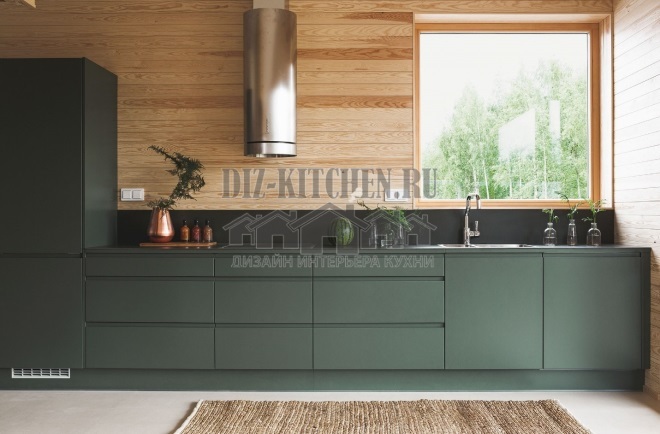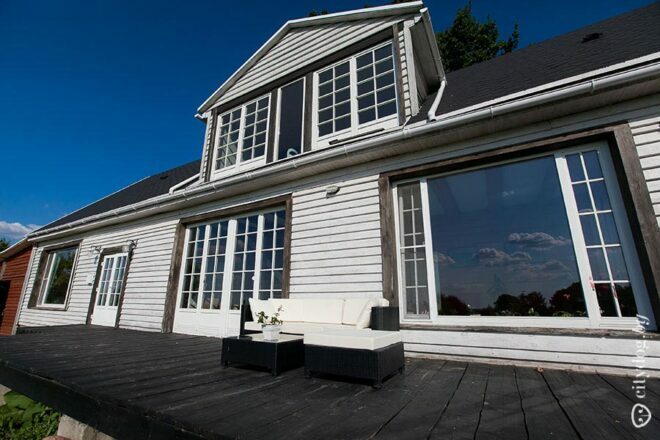For the convenience of cooking, multifunctional household appliances have been created. The typical gas stoves were replaced by individual units - hobs, ovens. A gas or electric oven allows you to follow classic recipes, embodying original culinary ideas. With proper placement, it takes up a minimum of usable area. Our review will acquaint you with the characteristics, installation features, rules for connecting the oven.

Classification
To make the cooking process comfortable, we select a model that matches your personal requirements. There are many details to consider that will be important in your case. The technical appliance is accompanied by the manufacturer's instructions, which describe the sequence of actions on how to install the built-in oven. Before buying a device, we study the parameters:
Attention! Earned on our website kitchen designer. You can familiarize yourself with it and design your dream kitchen for free! May also come in handy wardrobes designer.
- The power source is gas or electricity.
- The layout of the heating elements - top, bottom, combined heat supply.
- Installation option - embedded (dependent), standalone (independent).
- Dimensions - dimensions of a standard built-in unit: width - 59.5 cm, height - 59.5 cm, depth - no more than 56 cm. Parameters fluctuate ± 2 cm in specific models, depending on the manufacturer.
- Control method - mechanical, electronic, sensory, combined.
- Cleaning system - traditional, pyrolysis (self-cleaning function), hydrolysis, catalysis.
- Functionality - convection, microwave mode, heating from above or below, grill, temperature probe, automatic selection of parameters, “Pizza” mode.
- Security level - automatic electric ignition, gas control, emergency shutdown, door lock.
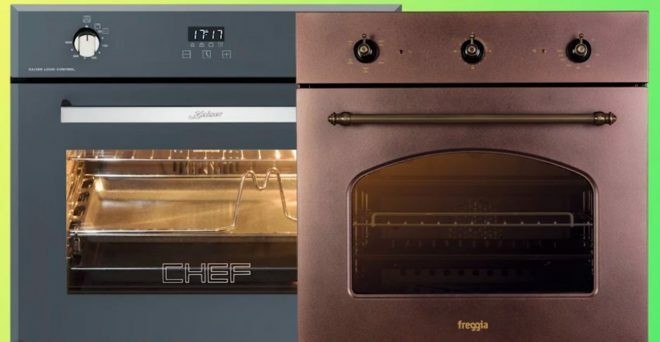
Image taken from https://www.youtube.com/watch? v = JXr-dWUHrH0
By installation method
There are two installation options:
- Embedded (dependent). This is a classic solution when the oven is located in the niche provided in the headset. The top part is the mounted hob, another work surface of the furniture. The device is also installed directly on the table top, placed in the section of the pencil case, raising it to eye level.
- Autonomous (independent). Creative design solution. The oven is located separately from the items in the kitchen set. The place for the equipment is chosen from the point of view of ease of use.

By type of food
To properly connect the oven, we select the model according to the heating method: gas or electricity. Each type of food has pros and cons.
Gas units are a familiar classic. The advantages of such ovens:
- low price;
- ease of use;
- independence from power supply;
- cheaper operating cost.
Disadvantages - uneven heat supply inside the device, due to which the product heats up and bakes poorly. Gas appliances have less functionality in comparison with electric ovens, insufficient security system (blue fuel may leak if the rules for connection and use are not followed).
An electrical device is a popular, popular technique, especially in high-rise buildings, where gas is simply prohibited. Such equipment is multifunctional, reliable, and convenient to operate. Most models are equipped with protective mechanisms to prevent overheating and ignition. The downside is the relatively high price of the product, the high cost of electricity. The use of an electric oven is undesirable in old, dilapidated buildings where the cables have not been replaced. Frequent power outages in rural areas prevent the full operation of the electrical unit.
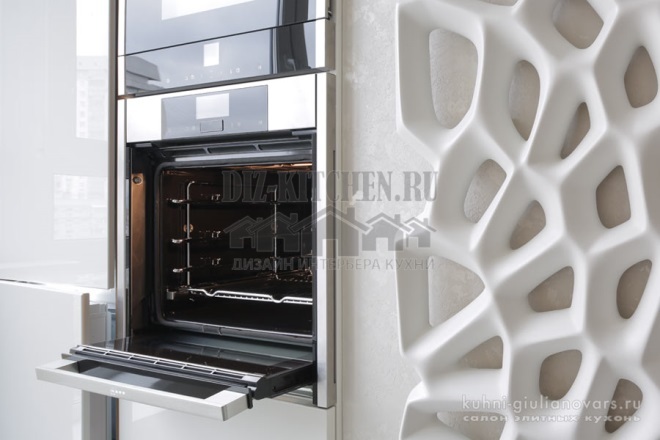
Oven prices
Ovens in a wide price range are presented in the catalogs of trading companies: from budget to luxury products. The cost of equipment depends on a number of characteristics: brand awareness, year of model creation, provided modes and functions, power consumption class, performance.
When purchasing, we are guided by a clear understanding in what conditions, with what frequency the kitchen appliance will be used. In Russia, the price of desktop mini-ovens starts from 2 thousand rubles (Cedar, BBK, Energy), built-in ovens cabinets cost in the range from 12,000 to 82,000 rubles, so each buyer will find a product that is acceptable for budget.
Siemens and Bosch are some of the most popular ovens. They were the first to have steam convection, a damping system in the door, and a modernized temperature probe. Candy, Gefest and Ariston are good budget models. For 12 thousand rubles, you can purchase a device with an economical class of electricity consumption, lighting, upper and lower grill, spit.
Samsung belongs to the middle price segment. Touch control, catalytic cleaning system, several dozen automatic programs, 3-layer tempered glass - all this can be purchased for $ 30,000. rubles (Samsung model NV70H5587BB).
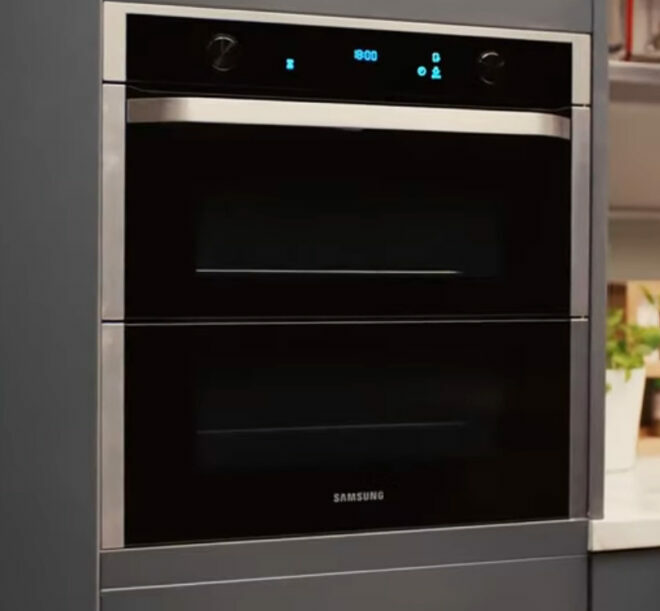
Image taken from https://www.youtube.com/watch? v = _kRs8iqHReo
Choosing a location
We carry out the determination of the place of installation of the oven thoughtfully and responsibly. The designated area must meet all fire safety criteria. The allocated area must have conditions for a durable, trouble-free functioning of the kitchen unit.
We place the device so that it does not interfere with the operation of other household appliances. We take into account the aspects:
- the material of adjacent furniture elements in contact with the oven must have a temperature resistance higher than 120 ° C;
- it is not allowed to install the oven next to refrigeration equipment without additional insulation;
- we place the electrical appliance away from the sink;
- we ensure normal circulation of air masses by having a gap of at least 5 cm between the rear, side panels of the oven and other kitchen items;
- the room in which the gas units are installed must be well ventilated;
- the rules for installing a gas-powered oven prohibit the triple branching of the gas riser;
- the kitchen power supply must be provided by a separate route from the distribution board;
- the socket must be grounded, the rating is at least 16 amperes, the degree of protection is at least IP44, the distance from the floor is at least 30 cm and not higher than 90 cm.

Image taken from https://www.youtube.com/watch? v = 3w0N8mCf1pE & t = 98s
Under the work surface or hob
Such a built-in oven, installed under a worktop or hob, has one significant advantage. This option is a suitable solution for small spaces. The design of such a kitchen looks stylish, laconic.
To place the device in the space under the work surface, follow the steps:
- we prepare a niche, make sure there are no distortions of the upper and side walls of the cabinet;
- in order to avoid chips along the inner edges of the compartment, we attach elastic protective strips;
- to prevent swelling, delamination of the headset material, we process the edge elements with a moisture-resistant sealant;
- we place the unit in the prepared area.
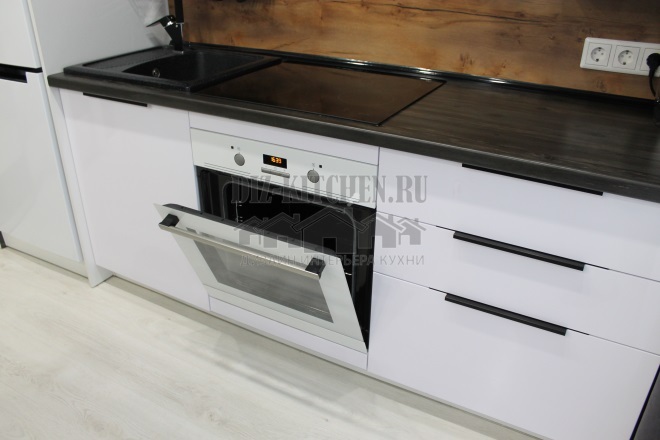
Column cabinets
This way of placing the oven is suitable for spacious kitchens. The unit is placed at eye level, which allows you to control the cooking process. Installation in column cabinets is convenient because the hostess does not need to bend over when using the device. The disadvantage is that a large item located on the survey looks cumbersome in a small room. There are also advantages - prevention of injuries to babies due to the inability to reach a working electrical appliance.
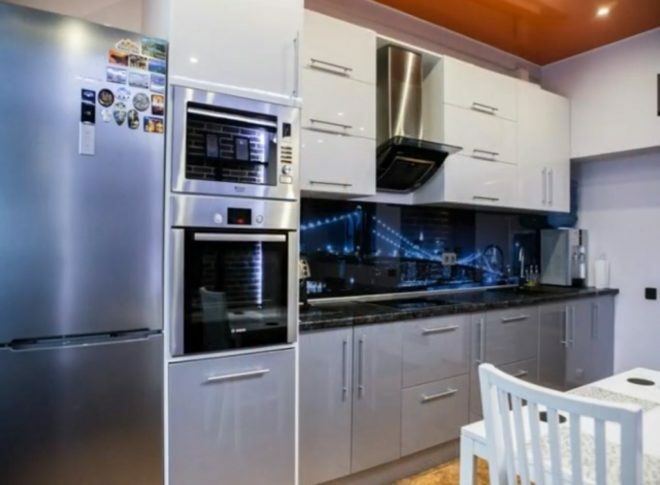
Image taken from https://www.youtube.com/watch? v = B5dQNcyCIn8
Into a tall kitchen cabinet
An interesting solution in a modern interior is the installation of an electric oven in the bedside table of the upper row of the headset. This method simplifies the operation of the device. Pros:
- no need to bend over while cooking;
- inaccessibility for kids;
- ease of placement of dishes.
Before installation, make sure that the furniture structure is strong enough to support the weight of the unit.
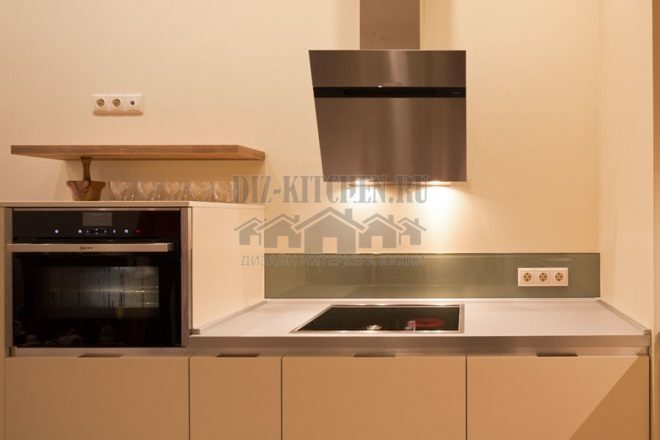
To the island
In a spacious kitchen with an organized island, you can put an oven under the worktop. Minus - the solution is inconvenient for housewives who often use the device. Before you finally connect the electric oven, decide which side is more convenient to approach the device from the point of view of the rule of the working triangle (in order to make a minimum of movements between the main zones).

In the corner
A way to use a small area wisely is to place the appliance in the corner of the headset. The kitchen unit can be mounted at any height to provide convenience and functionality. Some have an oven in the corner above the dishwasher or washing machine. This move will save space. However, experts do not advise placing heating equipment and a device that works with water in the immediate vicinity.

Photo by Rooky Yootz
Installing the built-in oven
We create a niche in advance that corresponds to the size of a particular device. Solution options:
- we provide a section when choosing a model or ordering furniture;
- we purchase (or rather order individually) a separate module designed for built-in ovens;
- select the most suitable area in an already installed headset;
- independently equip the necessary niche.
The electric oven must be installed in strict accordance with the manufacturer's instructions.
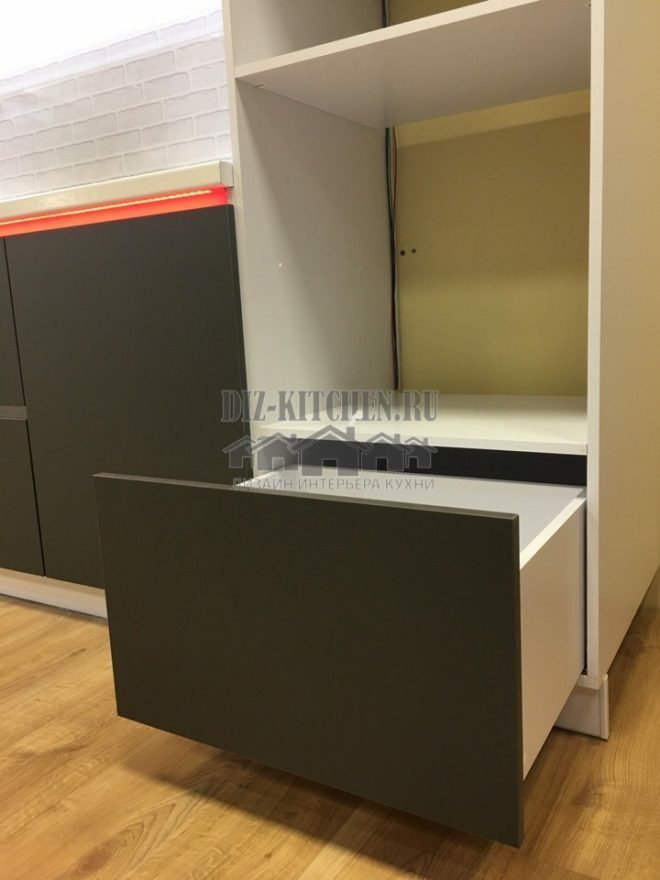
Installation features
The gas oven must be connected simultaneously with its placement in the designated compartment. Once the installation is complete, access to the back of the oven will be difficult. Algorithm of actions:
- If necessary, we redo the gas pipe into two separate outlets: for the top panel and the oven.
- Complete assembly of the parallel gas riser must be carried out prior to connection.
- We install two separate valves. We connect the hob to one tap, the oven to the other.
- Using a soapy solution, we make sure that it is tight. Apply the composition abundantly to the joints. The criterion for a good connection is the absence of soap bubbles.

Image taken from https://www.youtube.com/watch? v = 6bKEqYoSZZ0
Safety regulations
A piece of kitchen furniture, where an oven is built in, must meet all the requirements for safe operation. We take care when laying all wires, installing electrical accessories, connecting the core to the shield.
- Twisting of electrical wires is not allowed.
- Direct contact of cables made of different metals is prohibited.
- For the joint of wires, we use terminal blocks with a screw type of clamp.
- We make sure that the cable products are not damaged by the protective cover.
- Be sure to provide a grounding device.
Installation work
Since an electric oven is a high energy consumption appliance, it is recommended to install an additional line. The connection of the current-carrying conductor is carried out only through a separate circuit breaker.
If you need to build in the oven yourself, with your own hands, with a power of up to 3 kW in a room with modern lines designed for high loads, we connect through a standard "Euro socket". The hole diameter of these products is 4.8 mm, which corresponds to the Europlug plug.
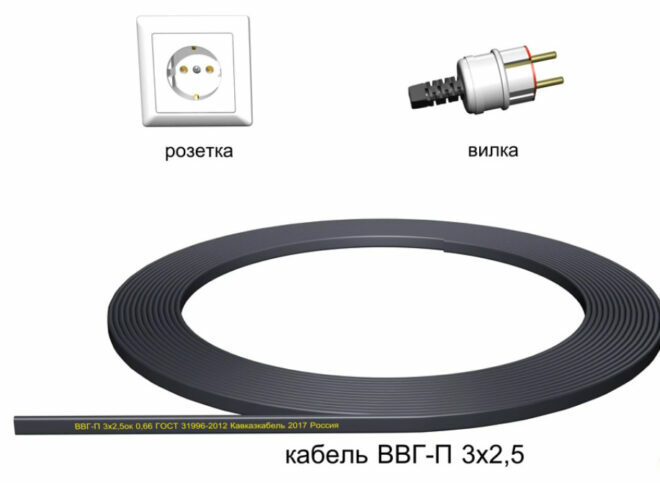
Image taken from https://www.youtube.com/watch? v = 3w0N8mCf1pE
Equipment check
Installation is completed with a trial commissioning. Before the first start, remove the remaining lubricants from the inner surfaces of the oven with a clean, soft, cloth napkin.
The first test is carried out “without load” - without loading food into the oven. We carry out the run at a temperature not exceeding 250 ° C. The duration of the test is 20-30 minutes. We check the serviceability of the device in all provided modes. We evaluate the quality of work of all mechanisms.
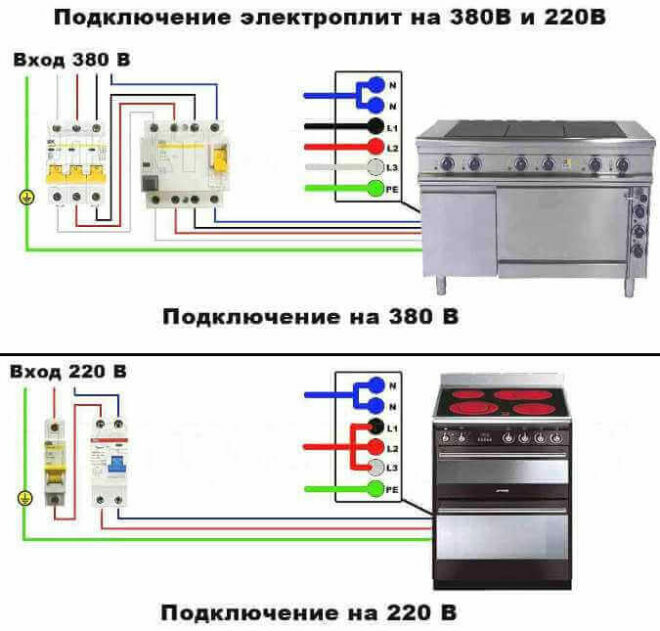
Electrical connection
It is not difficult to connect the device through a 16 amp electrical outlet that has a ground connection. If necessary, remove the cable from the junction box, follow the sequence:
- To connect the oven to the electrical network, we purchase a three-core VVG cable with a cross section of 4 sq. mm of the desired length.
- In a pre-arranged route, we lay the cable from the shield to the mounting box.
- After fixing, we connect the cable. We connect the white-coated wire to the bottom terminal. We bring the zero core (blue) to the lower terminal marked with the symbol N. We fix the grounding wire (yellow-green) in the free terminal clamp intended for grounding.
- We connect the socket in the installation box. The cable cores, marked in white and blue, are connected to the outer terminal clamps. We bring the yellow-green wire to the central junction.
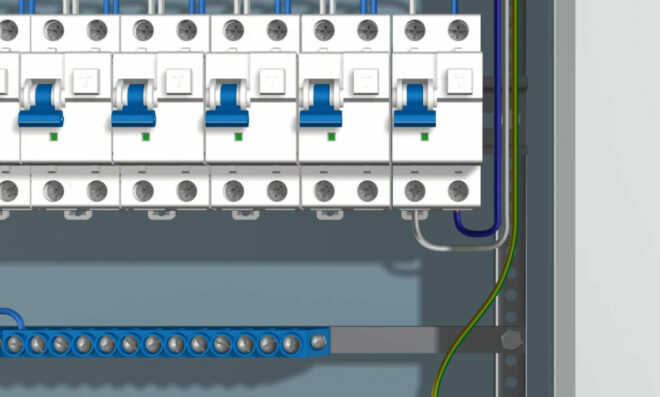
Image taken from https://www.youtube.com/watch? v = 3w0N8mCf1pE
Errors
A typical flaw that leads to knocking out of the machine is excessive load on the network. This happens when several electrical appliances are turned on, receiving power from the same wiring.
Failure of the cable insulation, damage to the power plug, socket outlet, flexible cord leads to a serious problem. Therefore, before connecting the device, it is necessary to check the physical integrity of the elements that conduct or receive electricity.
Mistakes in installing a gas oven are fraught with leakage of natural fuel, subsequent explosion, damage to property, and poisoning with volatile combustion products. A common violation is insufficient sealing of the connection points to the gas riser.

Image taken from https://www.youtube.com/watch? v = Y85T_F3U5VQ
If you carefully follow the manufacturer's instructions, you can install the oven yourself. Before buying an electrical appliance, you need to decide on the required functionality, take into account the nuances of the kitchen interior, the layout of the room.
average rating 0 / 5. Number of ratings: 0
No ratings yet. Be the first to rate.

